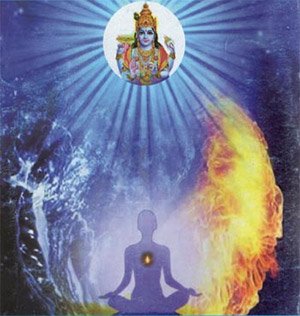Siddhanta Sangraha of Sri Sailacharya
by E. Sowmya Narayanan | 2008 | 30,562 words
Siddhanta Sangraha Chapter 13 (English translation), entitled “individual soul” as included in the critical edition and study. The Siddhanta Samgraha is a Sanskrit philosophical text dealing with Vishishtadvaita in five hundred Sanskrit verses. It was written by Shri Shailacarya (18th century) and closely follows the philosophy of Vedanta Deshika (13th century).
Chapter 13 - Individual Soul
127. This view is not acceptable to the wise as it is associated with many fallacies. Jīva is classified as two fold, namely, karma vidhura (one who is devoid of karma), karmavān (one who is associated with karma).
128. Out of these two, the first category is divided as nitya (eternally released) and mukta (released). Amount these, the nityas have the blissful experience of Brahman from the beginningless time.
129. The muktas will attain the brahmānubhava only through Śaraṇāgati anad Upāsana. According to some ācāryas, there is another category of jīvas namely, the nitya saṃsāri.
130. Through the scriptural statement ‘ekampāde noddharati sa līlārtham’ which means “the Supreme Lord will not annihilate a portion of līlā vibhūti; otherwise He will be bereft of līlārasa which is a sport to Him. From the above statement, according to some the baddha jīvas (nitya baddhas) are also like the nityas (nitya-muktas). This is called as the nityasaṃsāripakṣa.
Conclusion:
 This concludes Individual Soul according to Vishishtadvaita philosophy explained by Shri Shailacarya. This book follows the model of Vedanta Deshika although the Vishishta Advaita school was originally expounded by Shri Ramanuja. Vishishta-Advaita is one of the various sub-schools of Vedanta which itself represents one of the six orthodox schools of Hindu Philosophy. They highlight the importance of the Upanishads, the Bhagavad Gita and the Brahma Sutras.
This concludes Individual Soul according to Vishishtadvaita philosophy explained by Shri Shailacarya. This book follows the model of Vedanta Deshika although the Vishishta Advaita school was originally expounded by Shri Ramanuja. Vishishta-Advaita is one of the various sub-schools of Vedanta which itself represents one of the six orthodox schools of Hindu Philosophy. They highlight the importance of the Upanishads, the Bhagavad Gita and the Brahma Sutras.
